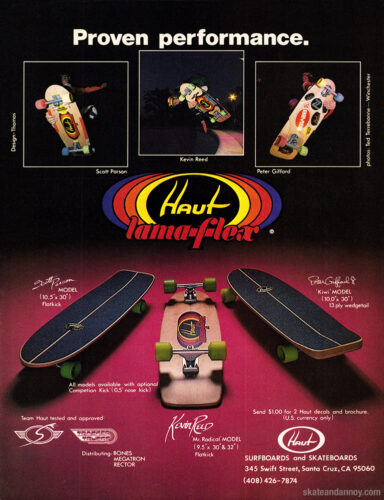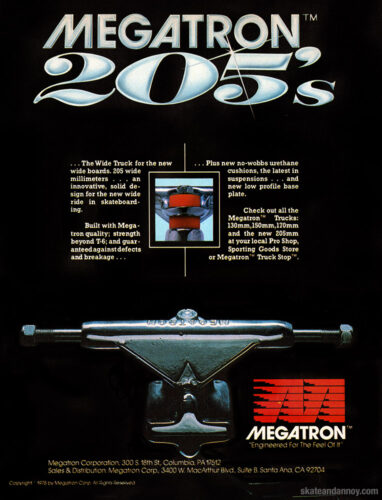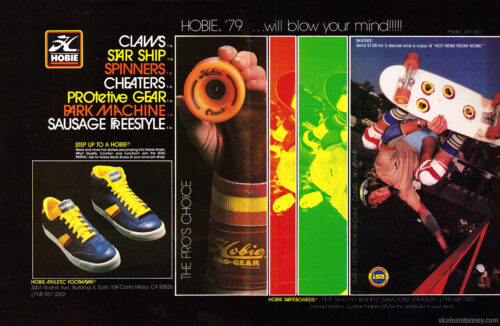
Walls Street Journal weighs in on blanks
The Wall Street Journal has an article on the blank skateboards titled “Avid Boarders Bypass Branded Gear: The $15 ‘Blank Decks’ Work Just Fine — A Marketing Challenge for Industry.”
Zoo York riders scored the photo incentives. If you’re hoping for the old school pen and ink renderings that they used to use for illustrations you’ll be disappointed. In fact the first composite illustration looks more like something out of a second rate USA Today. It’s like all those years without a photo editor have them crippled. One recurring theme is that the kids with real talent are the ones that are buying blanks, and the newbies are buying branded gear. I don’t know about your town, but I see mostly the opposite happening in Portland. The IASC is quoted, and even brings up their ill fated “A World Without Pros” campaign. Here are some interesting facts. There are an estimated 800 professional and semi-professional skateboarders on the industry’s payroll, and Santa Cruz (NHS actually) claims an R&D budget of $500,000 annually. There are a few factual anomalies in the article. Apparently in Sioux Falls Iowa you can buy a “complete” deck from Crown for $30, or a name brand for $60. I’m sure they meant deck only, but even so, $60 for a normal production run deck is a rip off. Another kid who broke his deck had to buy his own replacement when his mom refused to foot the bill. “…he chose a $130 one from Mystery Skateboards — on his own.” Someone should tell that kid that his trucks and wheels were still good. Read the Wall Street Journal. Just in case you are wondering, yes, we think Skate and Annoy is every bit as revered and important as the Wall Street Journal. More so, actually. Thanks to Michael Brooke for the tip off.
Avid Boarders Bypass Branded Gear
The $15 ‘Blank Decks’ Work Just Fine —
A Marketing Challenge for Industry
By PAUL GLADER
July 27, 2007; Page B1
Sixteen-year-old Matt Hiemstra should be the $5.2 billion-a-year skateboard industry’s ideal customer.
During the summer, he skateboards daily, and between the end of one school year and the beginning of the next, he breaks about eight boards doing jumps and other tricks. He also knows all about skateboards, including the names of the leading brands and the pros who endorse them.
But none of that knowledge really influences what he buys. “When it comes down to it, a skateboard is a skateboard,” says Mr. Hiemstra, who placed second and third at local competitions last year at Kuehn skate park in Sioux Falls, S.D. “It doesn’t matter that it has fancy stuff. When you go through so many in a summer, it’s too costly to buy expensive new ones.”
Some 12 million teenagers skateboard — more than play baseball in the U.S. today, estimates American Sports Data, a research firm based in Cortland Manor, N.Y. But Mr. Hiemstra and other skateboarders like him present an interesting marketing challenge. They are the industry’s prime customers, both devoted to the sport and savvy. And when they started out, most of them invested in premium boards and other branded gear. But as they got more serious about boarding, many decided they just didn’t care whether they used the industry’s top products, including the pro skateboard “decks” with graphics and branding that can cost between $40 and $70 without the wheels and the axles known as “trucks.”
In more mainstream sports like baseball, basketball and soccer, young athletes tend to respond to marketing by Nike Inc., Adidas AG and Under Armour Inc., paying top dollar for gloves, balls, shoes and other gear endorsed by their favorite stars. But many boarders think it’s just fine to buy “blank decks,” the plain, seven-ply wood boards that cost only $15 to $30, often come from overseas, and are being sold by big discounters, on eBay and at some skateboard specialty shops.
Mike May, a spokesman for the Sporting Goods Manufacturers Association in Washington, D.C., agrees that skateboarders can be a tough sell. “I think skateboarding is sort of in a class by itself in that respect,” he says. “There are some free spirits and independent thinkers in the skateboarding industry.”
Serious skateboarders also have big expenses. On average, those who execute tricky jumps, spins and slides break their boards once a month. “For a young kid, every couple dollars count,” says Issa Sawabini, a partner in Fuse, a Vermont-based youth sports marketing company.
Element, Zoo York, Santa Cruz, Flip and other top skateboard brands have been hiring the best of the estimated 800 professional and semiprofessional skateboarders to ride their boards and wear their brand-named clothes in competition, videos and ads. Many skateboard enthusiasts also admire top pros like Ryan Sheckler, Tony Hawk and Rob Dyrdeck for their ability to invent new tricks and for their celebrity lifestyles and clothing and equipment sponsorships.
But Mr. Hiemstra, who pays for his gear by bagging groceries at a local grocery store for $6.50 an hour, isn’t buying. He won’t settle for what he considers to be lesser quality boards sold at discounters like Wal-Mart or at toy stores. But he does sometimes bid for batches of closeout boards on eBay, and he trolls the four skateboard shops around Sioux Falls for sales, closeouts and other deals.
“Word travels around the skate park about what [various shops] have in stock,” he says, noting that he recently picked up two half-priced complete Crown boards from Scheels All Sports in Sioux Falls for $30 each instead of the usual $60 apiece.
The International Association of Skateboard Companies figures 50% to 70% of all the skateboard decks sold are blank rather than branded. “The problem is the blank boards don’t really contribute to the industry. They don’t buy advertisements in skateboard magazines. They don’t support professional riders,” says John Bernards, executive director of the International Association of Skateboard Companies, based in Santa Margarita, Calif.
Mr. Bernards’s group recently published an advertising supplement in skateboarding magazines called “Under Fire,” featuring interviews with pros, brand owners and distributors, to try to persuade young people to stop buying blank decks as a matter of principle. One author called blank decks “bland, unwarranted commodities that support faceless factories that do nothing to support professional skateboarding.”
But the effort backfired. “We got hate mail saying that we are trying to commercialize skateboarding,” says Mr. Bernards, whose group has now backed away from bad-mouthing blank decks.
Instead, the large skateboard brands have begun adding new technology, such as special footplates, air pockets, and layers of hemp fabric, Kevlar or fiberglass to absorb shock. The Habitat-brand skateboard deck has bamboo on the top to strengthen it.
NHS Inc., a Santa Cruz, Calif., company that owns several leading skateboard brands, has doubled its research and development budget to $500,000. Using cameras to film skateboards mounted on special board-breaking machines, NHS discovered that the top, rather than the bottom, is what usually breaks, prompting the company to add a special Kevlar layer.
“Sales are rising for that model,” says NHS’s president, Bob Denike. He is also looking at boards made by mixing fiberglass materials with wood and wood laminates. He argues that the industry is to blame for losing customers to cheap decks. “We don’t keep the product changing and moving forward,” he says. “When you have a 10-15 year run of no innovation, you leave the door wide open for an issue like this.”
The nation’s largest sporting-goods store, Pittsburgh-based Dick’s Sporting Goods Inc., sells skateboards at some of its 309 stores, and some of them are cheaper decks or blank decks. “We sell them because that’s what our customers want,” says Jeff Hennion, senior vice president and chief marketing officer. “If we aren’t providing the assortment the customers are looking for, they are going to go find it somewhere else.”
Fortunately for the industry, newer skateboarders, whose approach to the sport is more recreational than competitive, tend to appreciate branded gear more. Jack Lecci, 14, has been skateboarding for nearly three years with his friends in Pittsburgh. With few skate parks nearby, they ride their boards in parking garages near strip malls. So far, he has broken only one board, a premium model by Element. Coming off a set of stairs, “I fell right in the middle and it just completely snapped,” he says.
While the equipment failure was a mark of honor for Jack, it was also a breaking point for his mother, Mary Ann, who had bought the Element board for him for Christmas. She made him buy his replacement board — he chose a $130 one from Mystery Skateboards — on his own. “I bought him one. That was it! I won’t buy him another one,” she says. “If he wants to go get a job, that’s up to him.”
Jack is thinking of working as a golf caddy so that he’ll be able to pay for gear. He also says he plans to keep buying pro boards. But, he notes, if he gets better at tricks and starts breaking a board a month, he might change his mind and start buying blank decks.










Just to stir it up a lil bit all over again… I had to point this out…
blanks are “bland, unwarranted commodities that support faceless factories that do nothing to support professional skateboarding”…
Aren’t many blanks made in the same faceless factories that make the pro boards… don’t those factories literally and 100% support ALL skateboarding?
Anyway… sorry… nevermind… buy what ya like, and ride what ya buy…
Carry on… I’ll shut up.
I’ve met Jim Gray from ABC and Mick from M&M both cool dudes who make boards for several brands. It is possible to buy from someone who you know loves skateboarding.
im kinda interested in the potential for asian bamboo boards. it would be nice to know that whole swaths of forest arent being cut down just so i can ride a skateboard. fuck pro-models, as long as it rides, “johhny go-pro” doesnt deserve my 6$.
How can I tell the difference between BIRCH and MAPLE. Someone’s PHCUKING us..
I’m the owner of a shop. I tell the kids—it’s like buying a Titans’ jersey versus buying a plain jersey without the name. You don’t support the pros; don’t expect that when you get to be a pro, that the skaters will support you. It cost money to have pros–whether football, baseball, or skateboarding. For that pro to be sponsored, it requires sales of skateboards and equipment. Without it, there would be no pros to tour the country. Buying blanks does not benefit the pros! I want my kid to be supported if he makes pro, don’t you? This is one owner and skater mom’s opinion.
“don
for once, i find myself agreeing with enemy combatant. is it opposite day or someting? im gonna ride my non-branded board to the store to buy a newspaper to check.
“I want my kid to be supported if he makes pro, don’t you”?
No. I don’t care if your kid turns pro.
The big skateboard companies are all putting huge amounts of money into research and development, creating innovative products using cutting-edge technology. They provide lavish accommodations at their campuses with housing and support staff for the skaters and state of the art training and testing facilities.
Pro skaters also make huge personal investments
It is ironic that the most innovative new trucks, decks, and wheels all come from those types of skateboarding that have no sponsored pros whatsoever.
conahan’s shit was way too funy not to copy and paste it, so here it is again…
The big skateboard companies are all putting huge amounts of money into research and development, creating innovative products using cutting-edge technology. They provide lavish accommodations at their campuses with housing and support staff for the skaters and state of the art training and testing facilities.
Pro skaters also make huge personal investments
Hell, I’ve always liked the Gettysburg Address too: